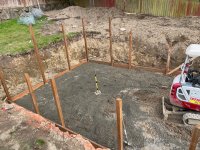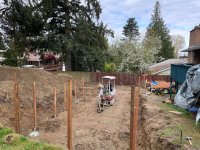Hey all just wanted to give my latest update and as usual ask a couple more questions of the resident experts. I have started putting the posts in as you can see from the pictures. Today I am getting another load of gravel delivered and there will be much spreading and compacting taking place over the next 24 hours. After that I will be setting the last posts and then starting to build the walls. I do have a question about drainage. It has been mentioned a couple of times, I think @kimkats mentioned saving some money for gravel for drainage. I am mostly just making this whole thing up as I go...I have a general plan and know what I need to do but am a little light on specifics and details. I know I need drainage and I was hoping to try to accomplish a few things.
What would you all recommend as far as drainage for the pool? I am thinking obviously something on the other side of the retaining wall but would that ditch/drain system need to be all the way around the pool or should it just be a line in back where the high side of the hill is and then run it down one side or the other and out the back of my yard? There is a city wastewater drain out that way. it has been raining quite a bit here lately (shocking I know) and the area that is all the way at the bottom of my hill along the fence line with my neighbor has become essentially quicksand. My guess is that is because their is nothing providing any drainage for that area as there is a footing underneath the fence and my neighbors yard is about 2' lower than mine so it is essentially a retaining wall in its own right. So I would like to put a french drain in that area.
Also the downspout in the corner of my house near the back garage door just drains right onto the ground and the ground is sloped pretty decent in that area so I thought I might remedy that by putting in an underground drain for that gutter system and downspout to discharge into. So my big idea was to somehow tie all of these systems together but Im a little unsure of exactly how to go about that especiallty since all these different areas are at very different elevations.
Does anyone have a good resource you could point me to so I could get a decent introduction into how these different systems work and things I need to keep in mind or look out for when planning this thing?
As usual I appreciate all of your feedback everyone, thanks!
What would you all recommend as far as drainage for the pool? I am thinking obviously something on the other side of the retaining wall but would that ditch/drain system need to be all the way around the pool or should it just be a line in back where the high side of the hill is and then run it down one side or the other and out the back of my yard? There is a city wastewater drain out that way. it has been raining quite a bit here lately (shocking I know) and the area that is all the way at the bottom of my hill along the fence line with my neighbor has become essentially quicksand. My guess is that is because their is nothing providing any drainage for that area as there is a footing underneath the fence and my neighbors yard is about 2' lower than mine so it is essentially a retaining wall in its own right. So I would like to put a french drain in that area.
Also the downspout in the corner of my house near the back garage door just drains right onto the ground and the ground is sloped pretty decent in that area so I thought I might remedy that by putting in an underground drain for that gutter system and downspout to discharge into. So my big idea was to somehow tie all of these systems together but Im a little unsure of exactly how to go about that especiallty since all these different areas are at very different elevations.
Does anyone have a good resource you could point me to so I could get a decent introduction into how these different systems work and things I need to keep in mind or look out for when planning this thing?
As usual I appreciate all of your feedback everyone, thanks!



